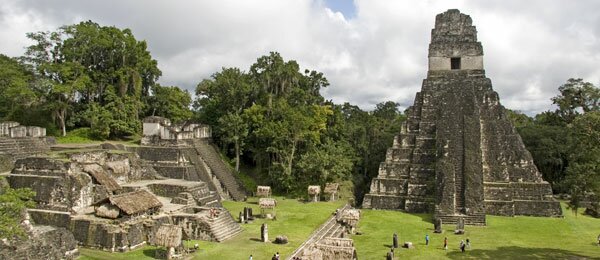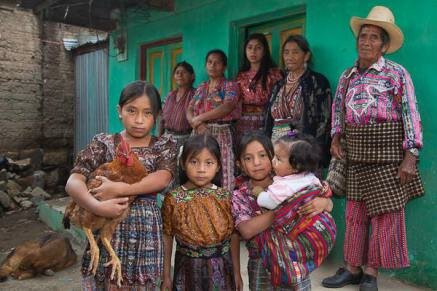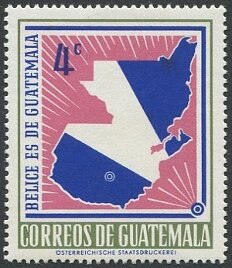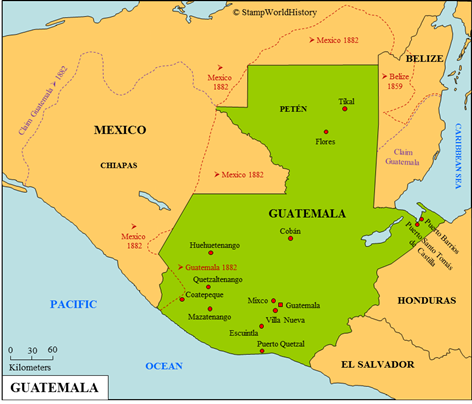
Guatemala
Quick reference
General issues: Republic 1871-Present
Country name on general issues: Guatemala
Currency: 1 Peso = 8 Reales = 100 Centavos 1871-1927, 1 Quetzal = 100 Centavos 1927-Present
Population: 885 000 in 1900, 15 806 000 in 2014
Political history Guatemala
Colonization and the road to independence
Guatemala is located in Central America. In the first millennium, Guatemala was one of the main centers of the Maya civilization. The city of Tikal was one of the largest Mayan cities and today is a major archaeological site. The larger Maya kingdoms dissolved in the 10th century and, just prior to colonization, a number of smaller kingdoms of Mayan descent were to be found in Guatemala. The Spanish colonized Guatemala from Mexico from 1523. The southern part of Guatemala was effectively colonized by 1530. The northern part would resist the Spanish well into the 17th century. The last Maya kingdom was subdued in 1697. During the colonial period, Guatemala was governed as a province of the Captaincy General of Guatemala – legally part of the Viceroyalty of New Spain but in practice self governing.
After Napoleon had conquered Spain, a wave of independence movements swept across the Spanish possessions in the Americas. The war of independence in Central America was mainly fought from 1810 in the Viceroyalty of New Spain, that gained independence as the empire of Mexico in 1821. The provinces of the Captaincy General of Guatemala proclaimed independence from Spain the same year – without a shot being fired. In 1822, the provinces joined the empire of Mexico. The empire, however, was short lived and, as the empire was dissolved in 1823, the provinces of the former Captaincy General proclaimed independence from Mexico as the United Provinces of Central America. By the constitution of 1824, the provinces would form the federal republic of Central America. The province of Guatemala was proclaimed the state of Guatemala in the same year. The federal republic of Central America would suffer from conflicts between the member states and that would soon lead to its dissolution. Guatemala became the fully independent State of Guatemala in 1839 and Guatemala was proclaimed a republic in 1847.
Establishing the borders

Tikal was the capital of one of the largest Maya kingdoms. The city was at its height from 200 AD until 900 AD. The ruins were discovered in 1848.
De facto borders with El Salvador and Honduras were established in the 1820’s, based on the borders of the former provinces of the Captaincy General of Guatemala. It would take over a century before de jure borders would be established. The border with Honduras was formalized in 1933 and the border with El Salvador in 1935 – both largely along the lines of the existing borders.
Establishing the border with Mexico was more complex. As was the case with El Salvador and Honduras, a de facto border was established in the 1820’s. However, both Guatemala and Mexico claimed larger parts of each others territory. Guatemala claimed the Mexican province of Chiapas which had been one of the provinces of the Captaincy General of Guatemala. When the other provinces of the Captaincy General, in 1823, proclaimed independence from Mexico as the United provinces of Central America, Chiapas voted to stay a part of Mexico. Guatemala has since then claimed Chiapas. Mexico, on the other hand, claimed parts of the Petén province of Guatemala. A treaty settling the borders was signed in 1882 – a treaty that favored Mexico. Guatemala reneged its claim on Chiapas and Mexico gained parts of the Petén province. Demarcation of the border was finished in 1902.
The border with Belize is disputed until today. The Spanish had, by treaties signed in 1783 and 1786, granted the British the right to settle in what is now Belize. The British in 1834 extended their claim to a substantially larger territory than the territory agreed upon in the treaties with Spain. A treaty was signed in 1859 with Guatemala, by which the borders as we know them today were established. As compensation for the territory that the British had gained, the British would construct a railroad connecting Guatemala to the Caribbean Sea through Belize. In 1940, Guatemala abrogated the agreement, based on the fact that the railroad was never built, and renewed its claims to Belize. Guatemala recognized independent Belize in 1991, but, until today, claims a substantial part of is territory.
Independence

A modern day Mayan family. In modern day Guatemala the Maya form a large, but disadvantaged, population group.
Throughout the the 19th century and the first half of the 20th century Guatemala was governed by dictators. Presidents were affiliated either with the Conservatives or the Liberals – the two parties that long dominated Guatemalan politics. Liberal presidents in the last quarter of the 19th century modernized the country. Coffee was introduced as an important cash crop next to sugar cane, that had been the most important crop in colonial times. In 1901, a concession was granted to the United Fruit Company – a United States owned company – for the production of bananas. The United Fruit Company[1]Currently Chiquita Brands International. would come to own over 40% of the arable land in Guatemala and gain great political influence. The first democratic elections were held in 1945. Almost a decade of political and economic reforms followed. The backlash came in 1954 when a military coup, backed by the United States, brought the military to power. The opposition against the military soon organized itself in guerrilla movements and, from 1960, Guatemala would be in a state of civil war. The guerrilla movements had their roots mainly in the rural Mayan parts of Guatemala. The military ruled Guatemala until 1986 when democracy was restored. Peace talks between the government and guerrilla movements were started and a peace agreement was reached in 1996, ending the civil war. Since 1986, Guatemala has been ruled by democratically elected presidents.
The Guatemalan economy is traditionally based on agriculture. Although the economy has diversified, sugar, coffee and bananas are the most important export products until today. Guatemala is qualified as a middle high development country on the United Nations Human Development Index and, after Honduras, has the second lowest ranking of the countries in Central America. Mestizos – people of mixed white and Amerindian origin – account for 60% of the population. Amerindians of Mayan origin account for 40% of the population. The economic and social development of the Amerindian population is significantly lower than the national average.
Postal history Guatemala

1967 – The stamp shows a map of Guatemala including Belize. The text reads ‘Belice es de Guatemala’ or ‘Belize belongs to Guatemala’.
Guatemala issued its first stamps in 1871. The stamps were printed by the French Imprimerie Nationale in Paris and show the seal of Guatemala. Until the 1960’s, stamps of Guatemala were printed by a wide range of renowned printers abroad, such as the American Bank Note Company in New York, Waterlow & Sons in London and many more. In the classical era relatively few stamps of new designs were issued. However, many provisionals were issued – available stamps overprinted with new face values. Guatemala has, from its first issue until the present day, issued stamps mainly with themes of national interest.
Album pages
← Previous page: GuadeloupeNext page: Guyana →




